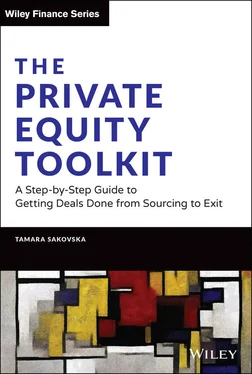Create desire. This is a good time to mention your fund's other relevant successful investments and explain how you were able to create tangible benefits for your portfolio companies. Provide enough detail about the issues faced by other businesses and describe how your fund was able to resolve them. Draw any meaningful parallels between your past investments and current situation.
Overcome objections. Acknowledge any concerns that the company might have about accepting a private equity investment from your fund. Listen attentively and try your best to understand the company's perspective. Then isolate each objection and try to deal with one concern at a time. You might need to follow up with additional information after the meeting to strengthen your position.
Close. One of the best possible outcomes of this meeting will be agreeing with the company on a set of actionable next steps. Hopefully, you managed to establish a strong bond with the management team and prepare a fertile ground for any subsequent follow-ups.
What happens next? There are three possible scenarios. The first one is that the initial meeting equipped you with enough disappointing information about the business to enable you to conclude that you are not interested in moving forward. In this case, it is best to thank the management team for their time, provide them with your honest feedback about why the company does not quite fit your mandate at present and discuss what business adjustments would be required for this decision to change in the future. The second scenario is that you like the business but you sense that the company will not be ready to accept a private equity investment for a considerable time. In this case, you need to make sure that you communicate your continued interest and schedule a follow-up meeting at some point in the future. I believe that keeping in touch with the company will allow you to build a good relationship with the management team over time and enable you to create enough neural pathways in their minds that might ultimately pave the way to a transaction with your fund.
The third and best scenario is that you like the business, and the company owners are ready to consider a potential investment from your fund. It means that the thematic sourcing approached worked and you are ready to start work on a new transaction, possibly even a proprietary one. Now is a good time to sign a confidentiality agreement and request enough information regarding company operations, business strategy, growth opportunities and financial performance to properly evaluate this investment opportunity.
Well, you have made it to the end of the ICEBERG Roadmap™. I know: it is a long and arduous journey to read through these 7 steps in detail. However, I believe that this framework (or your own adapted version thereof) will improve your deal sourcing approach and ability to deliver deals. Hopefully, proprietary ones.
1 1ICEBERG Roadmap™ is a registered trademark of my company, Lavra Group Limited.
2 2For a comprehensive external environment analysis tool, please refer to Narayanan and Fahey (2001). Please refer to Chapter 2 References for a complete citation.
3 3Porter (1985) provides a thorough analysis of all original elements of the industry structure (“Porter's Five Forces”), while Grant (2002) offers an extended framework to suit more contemporary sectors. Please refer to Chapter 2 References for complete citations.
4 4For ideas about how to get started on a private survey, you may find it helpful to read Chapter 13of Valentine (2011). Please refer to Chapter 2 References for a complete citation.
5 5Kevin Landry, the CEO of TA Associates, gave an interview in 2013 that appeared in the Private Debt Investor's article titled “Cold Call Captain.” He explained his firm's cold calling philosophy and provided a couple of interesting facts: at that time, his firm worked through a database of 280,000 companies and his team made unsolicited calls to over 8,000 businesses a year.
3 Opportunistic Deal Sourcing
Key Topics in Chapter 3:
Develop an edge in opportunistic deal sourcing with the DATABASE Roadmap™
No luck required: why having a clear focus pays off in an opportunistic deal search
Actions you can take now to get the most out of your professional network
How active brand management can help your fund stay top of mind
Creative ways to supplement your opportunistic deal ideas
How to manage your deal origination workflows effectively and effortlessly
Does a dedicated business development function work for everyone?
Developing an Edge in Opportunistic Deal Sourcing
Do you know what sourcing strategy is used by private equity professionals most often? I believe an overwhelming majority of all private equity transactions executed each year around the world are opportunistic. No matter what geography you look into, you are likely to observe a similar theme: private equity funds are expected to network with intermediaries, analyze pitchbooks and investment memoranda, attend company meetings and write numerous offer letters—all in hopes of executing a good deal. Some funds might develop a “deal angle,” and some funds might not even do that—private equity professionals are under immense pressure to stay open-minded in an opportunistic environment.
Many funds choose to maximize their options by increasing the total number of investment opportunities they review every year. There is nothing wrong with this approach, provided you have enough time and bandwidth. Think about what takes up your resources: an average deal professional with a couple of years of private equity experience might amass over 1,000 industry-related connections. A good investment banker active in private equity transactions for at least a decade will probably have enough contacts to fill a large cruise ship. The people you meet professionally often seek to be in touch, send investment ideas, request meetings and, through various means, gently bombard you with vast amounts of information, only a small proportion of which might be relevant to your fund. Generally speaking, everyone in the private equity industry is reasonably well-connected, keen to get deals done and competing in a market with diminishing knowledge barriers. This makes the job of a private equity investor very difficult because the market is definitely overcrowded and information is overabundant.
How can you possibly gain an edge over your competition in this environment? How can you make sure that your opportunistic deal search is not just busy work, but a productive process with a good chance of uncovering a gem of an investment? Having spent considerable time thinking about it, I have settled on the two key factors that matter most. First, staying top of mind with your most relevant contacts, and second, getting the most out of your time by reviewing only relevant deals.
If you experience severe time constraints and are not able to dedicate resources at present to developing a systematic approach for finding opportunistic deals, you will vastly improve the quality of your opportunistic deal search by focusing on just these two areas. Spending time on relevant deals with relevant people should function as a powerful antidote to the intrinsic randomness of opportunistic transactions. Focus on these two things and see what happens. My guess is that you will cut through the noise in order to isolate only those deals that represent the best fit with your investment mandate.
And yet it is hard to see what can surpass a systematic deal sourcing approach if you are looking to build value for your franchise in the long term. Once you set the objective of generating a sustainable flow of high-quality opportunistic ideas, you have to invest some initial time and resources in order to lay a solid foundation.
Читать дальше












